Marketing Mix Elements Impact on Customer Purchasing Intention
VerifiedAdded on 2022/11/18
|24
|4192
|440
Project
AI Summary
This Integrated Business Management Project explores the relationship between marketing mix elements (product, price, place, and promotion) and customer purchasing intention, using Coles Supermarket in Australia as a case study. The project employs a deductive research approach, primarily utilizing surveys of 100 Coles customers across five Melbourne supermarkets. The methodology includes a structured questionnaire with both open-ended and closed-ended questions, coupled with statistical and content analysis techniques to interpret the data. The literature review examines existing research on marketing mix strategies, customer purchasing behavior, and the impact of marketing mix elements on consumer decisions. The project aims to identify how different marketing mix elements influence consumer purchase intentions, with the goal of providing insights for effective marketing strategies. The project also includes a Gantt chart detailing the timeline of the research, from problem identification to conclusion.
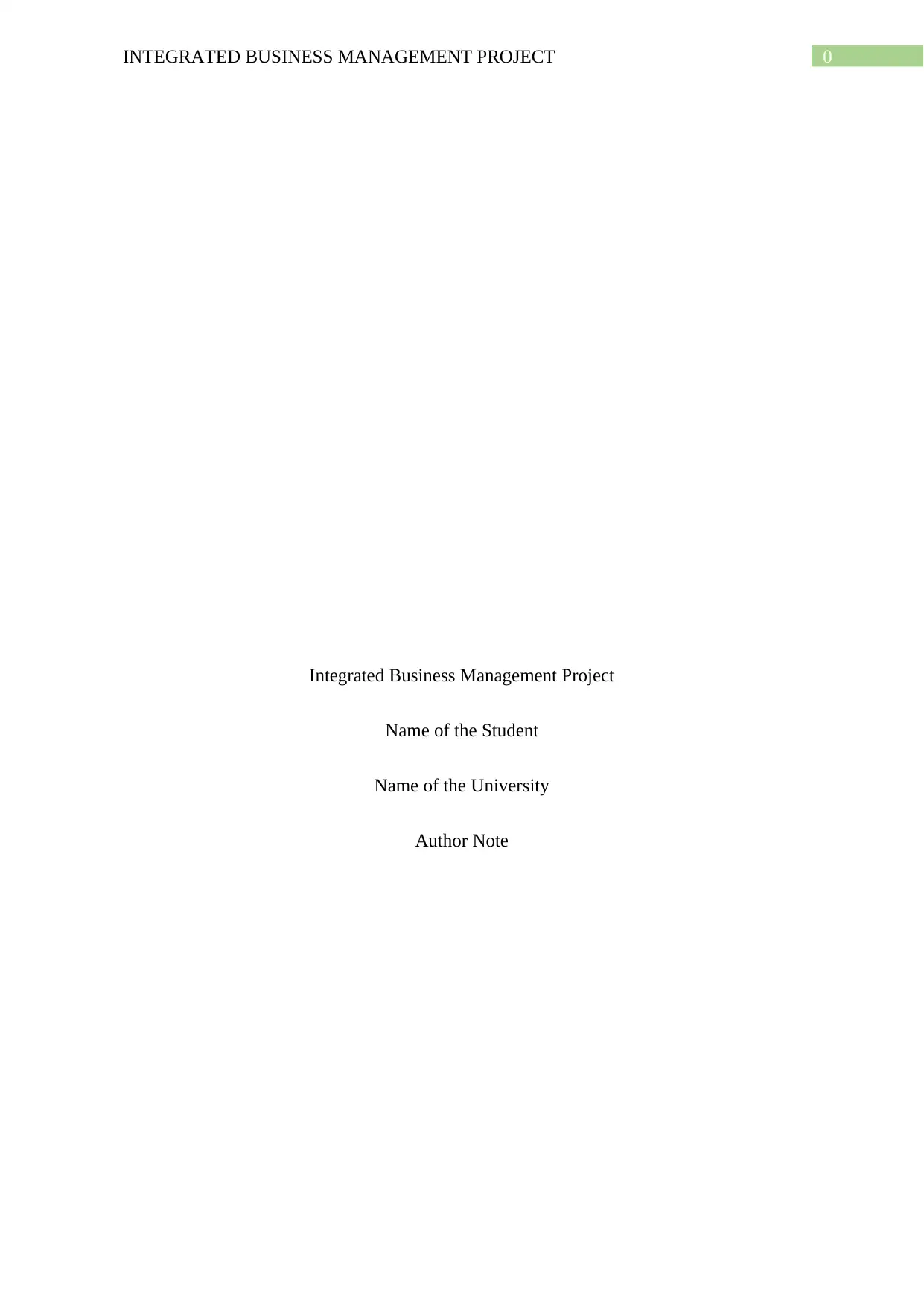
0INTEGRATED BUSINESS MANAGEMENT PROJECT
Integrated Business Management Project
Name of the Student
Name of the University
Author Note
Integrated Business Management Project
Name of the Student
Name of the University
Author Note
Paraphrase This Document
Need a fresh take? Get an instant paraphrase of this document with our AI Paraphraser
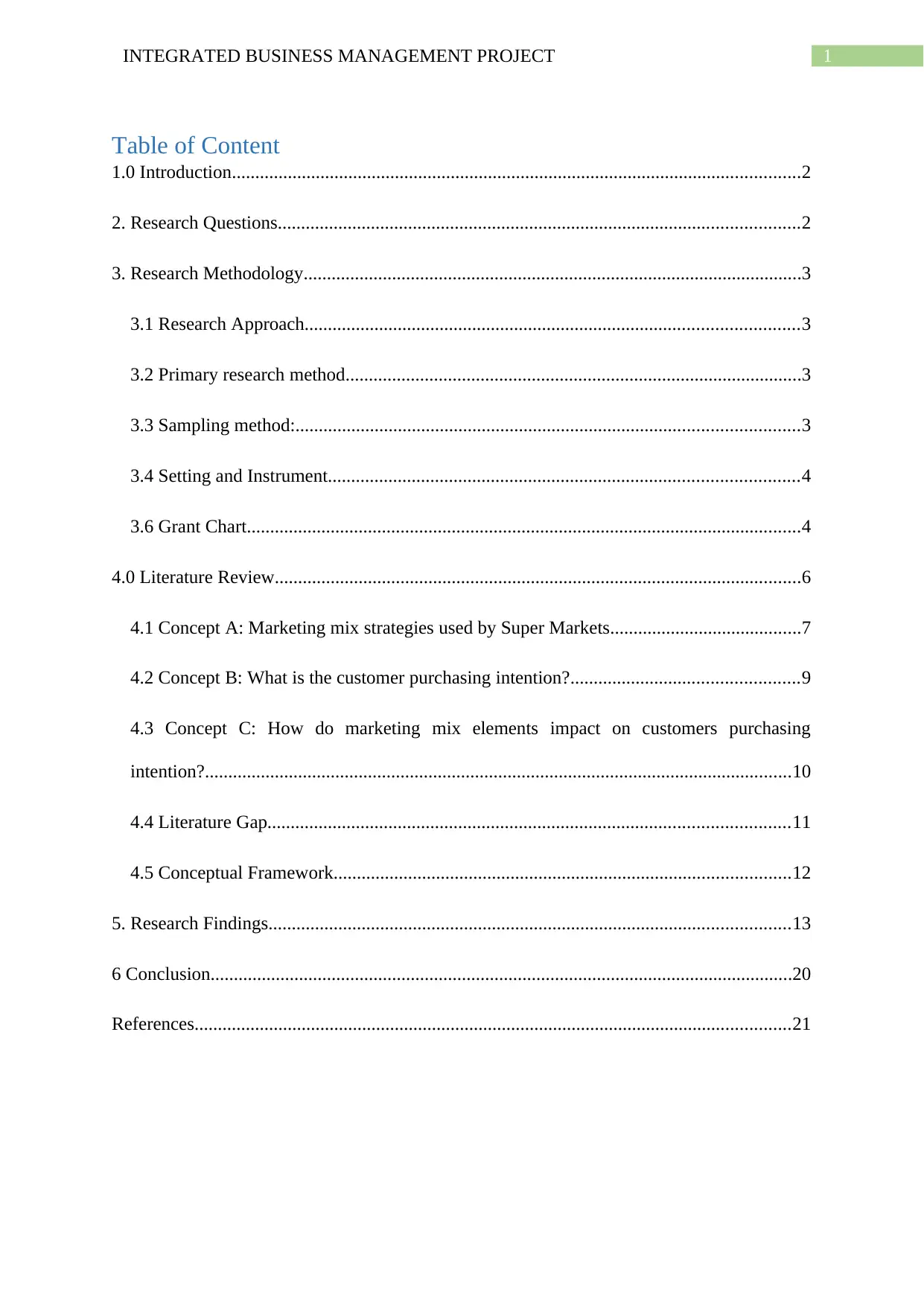
1INTEGRATED BUSINESS MANAGEMENT PROJECT
Table of Content
1.0 Introduction..........................................................................................................................2
2. Research Questions................................................................................................................2
3. Research Methodology...........................................................................................................3
3.1 Research Approach..........................................................................................................3
3.2 Primary research method..................................................................................................3
3.3 Sampling method:............................................................................................................3
3.4 Setting and Instrument.....................................................................................................4
3.6 Grant Chart.......................................................................................................................4
4.0 Literature Review.................................................................................................................6
4.1 Concept A: Marketing mix strategies used by Super Markets.........................................7
4.2 Concept B: What is the customer purchasing intention?.................................................9
4.3 Concept C: How do marketing mix elements impact on customers purchasing
intention?..............................................................................................................................10
4.4 Literature Gap................................................................................................................11
4.5 Conceptual Framework..................................................................................................12
5. Research Findings................................................................................................................13
6 Conclusion.............................................................................................................................20
References................................................................................................................................21
Table of Content
1.0 Introduction..........................................................................................................................2
2. Research Questions................................................................................................................2
3. Research Methodology...........................................................................................................3
3.1 Research Approach..........................................................................................................3
3.2 Primary research method..................................................................................................3
3.3 Sampling method:............................................................................................................3
3.4 Setting and Instrument.....................................................................................................4
3.6 Grant Chart.......................................................................................................................4
4.0 Literature Review.................................................................................................................6
4.1 Concept A: Marketing mix strategies used by Super Markets.........................................7
4.2 Concept B: What is the customer purchasing intention?.................................................9
4.3 Concept C: How do marketing mix elements impact on customers purchasing
intention?..............................................................................................................................10
4.4 Literature Gap................................................................................................................11
4.5 Conceptual Framework..................................................................................................12
5. Research Findings................................................................................................................13
6 Conclusion.............................................................................................................................20
References................................................................................................................................21

2INTEGRATED BUSINESS MANAGEMENT PROJECT
⊘ This is a preview!⊘
Do you want full access?
Subscribe today to unlock all pages.

Trusted by 1+ million students worldwide
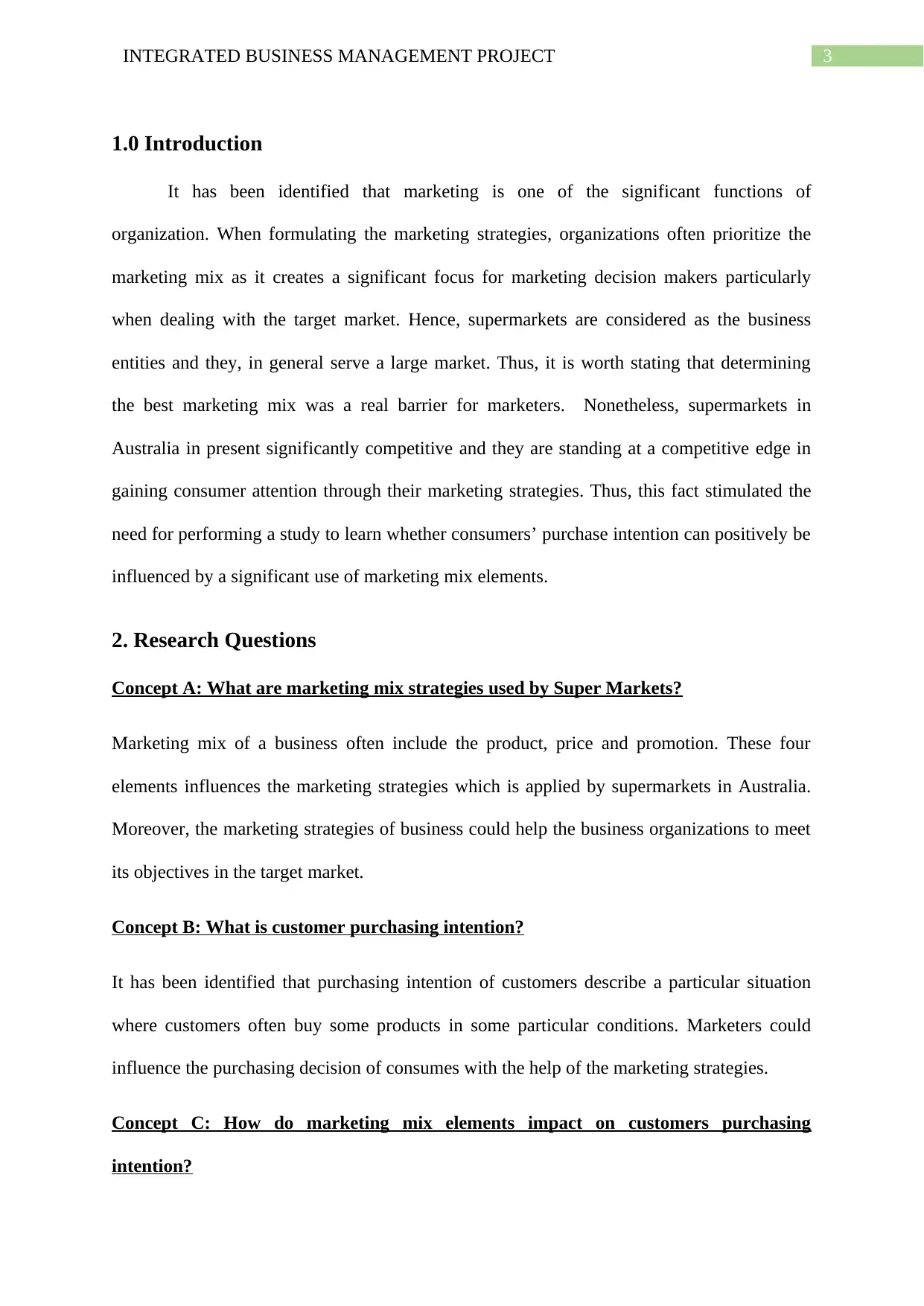
3INTEGRATED BUSINESS MANAGEMENT PROJECT
1.0 Introduction
It has been identified that marketing is one of the significant functions of
organization. When formulating the marketing strategies, organizations often prioritize the
marketing mix as it creates a significant focus for marketing decision makers particularly
when dealing with the target market. Hence, supermarkets are considered as the business
entities and they, in general serve a large market. Thus, it is worth stating that determining
the best marketing mix was a real barrier for marketers. Nonetheless, supermarkets in
Australia in present significantly competitive and they are standing at a competitive edge in
gaining consumer attention through their marketing strategies. Thus, this fact stimulated the
need for performing a study to learn whether consumers’ purchase intention can positively be
influenced by a significant use of marketing mix elements.
2. Research Questions
Concept A: What are marketing mix strategies used by Super Markets?
Marketing mix of a business often include the product, price and promotion. These four
elements influences the marketing strategies which is applied by supermarkets in Australia.
Moreover, the marketing strategies of business could help the business organizations to meet
its objectives in the target market.
Concept B: What is customer purchasing intention?
It has been identified that purchasing intention of customers describe a particular situation
where customers often buy some products in some particular conditions. Marketers could
influence the purchasing decision of consumes with the help of the marketing strategies.
Concept C: How do marketing mix elements impact on customers purchasing
intention?
1.0 Introduction
It has been identified that marketing is one of the significant functions of
organization. When formulating the marketing strategies, organizations often prioritize the
marketing mix as it creates a significant focus for marketing decision makers particularly
when dealing with the target market. Hence, supermarkets are considered as the business
entities and they, in general serve a large market. Thus, it is worth stating that determining
the best marketing mix was a real barrier for marketers. Nonetheless, supermarkets in
Australia in present significantly competitive and they are standing at a competitive edge in
gaining consumer attention through their marketing strategies. Thus, this fact stimulated the
need for performing a study to learn whether consumers’ purchase intention can positively be
influenced by a significant use of marketing mix elements.
2. Research Questions
Concept A: What are marketing mix strategies used by Super Markets?
Marketing mix of a business often include the product, price and promotion. These four
elements influences the marketing strategies which is applied by supermarkets in Australia.
Moreover, the marketing strategies of business could help the business organizations to meet
its objectives in the target market.
Concept B: What is customer purchasing intention?
It has been identified that purchasing intention of customers describe a particular situation
where customers often buy some products in some particular conditions. Marketers could
influence the purchasing decision of consumes with the help of the marketing strategies.
Concept C: How do marketing mix elements impact on customers purchasing
intention?
Paraphrase This Document
Need a fresh take? Get an instant paraphrase of this document with our AI Paraphraser
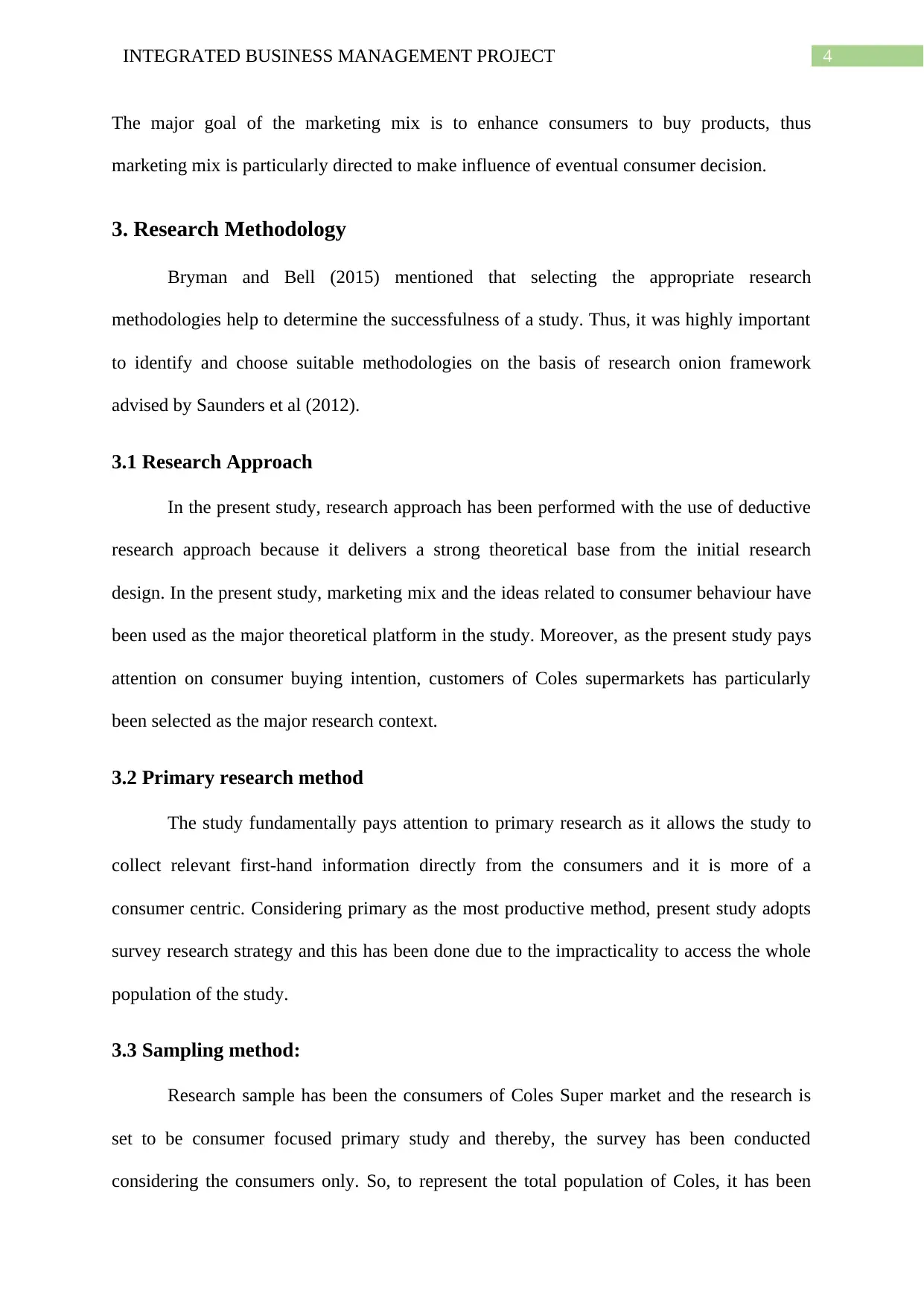
4INTEGRATED BUSINESS MANAGEMENT PROJECT
The major goal of the marketing mix is to enhance consumers to buy products, thus
marketing mix is particularly directed to make influence of eventual consumer decision.
3. Research Methodology
Bryman and Bell (2015) mentioned that selecting the appropriate research
methodologies help to determine the successfulness of a study. Thus, it was highly important
to identify and choose suitable methodologies on the basis of research onion framework
advised by Saunders et al (2012).
3.1 Research Approach
In the present study, research approach has been performed with the use of deductive
research approach because it delivers a strong theoretical base from the initial research
design. In the present study, marketing mix and the ideas related to consumer behaviour have
been used as the major theoretical platform in the study. Moreover, as the present study pays
attention on consumer buying intention, customers of Coles supermarkets has particularly
been selected as the major research context.
3.2 Primary research method
The study fundamentally pays attention to primary research as it allows the study to
collect relevant first-hand information directly from the consumers and it is more of a
consumer centric. Considering primary as the most productive method, present study adopts
survey research strategy and this has been done due to the impracticality to access the whole
population of the study.
3.3 Sampling method:
Research sample has been the consumers of Coles Super market and the research is
set to be consumer focused primary study and thereby, the survey has been conducted
considering the consumers only. So, to represent the total population of Coles, it has been
The major goal of the marketing mix is to enhance consumers to buy products, thus
marketing mix is particularly directed to make influence of eventual consumer decision.
3. Research Methodology
Bryman and Bell (2015) mentioned that selecting the appropriate research
methodologies help to determine the successfulness of a study. Thus, it was highly important
to identify and choose suitable methodologies on the basis of research onion framework
advised by Saunders et al (2012).
3.1 Research Approach
In the present study, research approach has been performed with the use of deductive
research approach because it delivers a strong theoretical base from the initial research
design. In the present study, marketing mix and the ideas related to consumer behaviour have
been used as the major theoretical platform in the study. Moreover, as the present study pays
attention on consumer buying intention, customers of Coles supermarkets has particularly
been selected as the major research context.
3.2 Primary research method
The study fundamentally pays attention to primary research as it allows the study to
collect relevant first-hand information directly from the consumers and it is more of a
consumer centric. Considering primary as the most productive method, present study adopts
survey research strategy and this has been done due to the impracticality to access the whole
population of the study.
3.3 Sampling method:
Research sample has been the consumers of Coles Super market and the research is
set to be consumer focused primary study and thereby, the survey has been conducted
considering the consumers only. So, to represent the total population of Coles, it has been
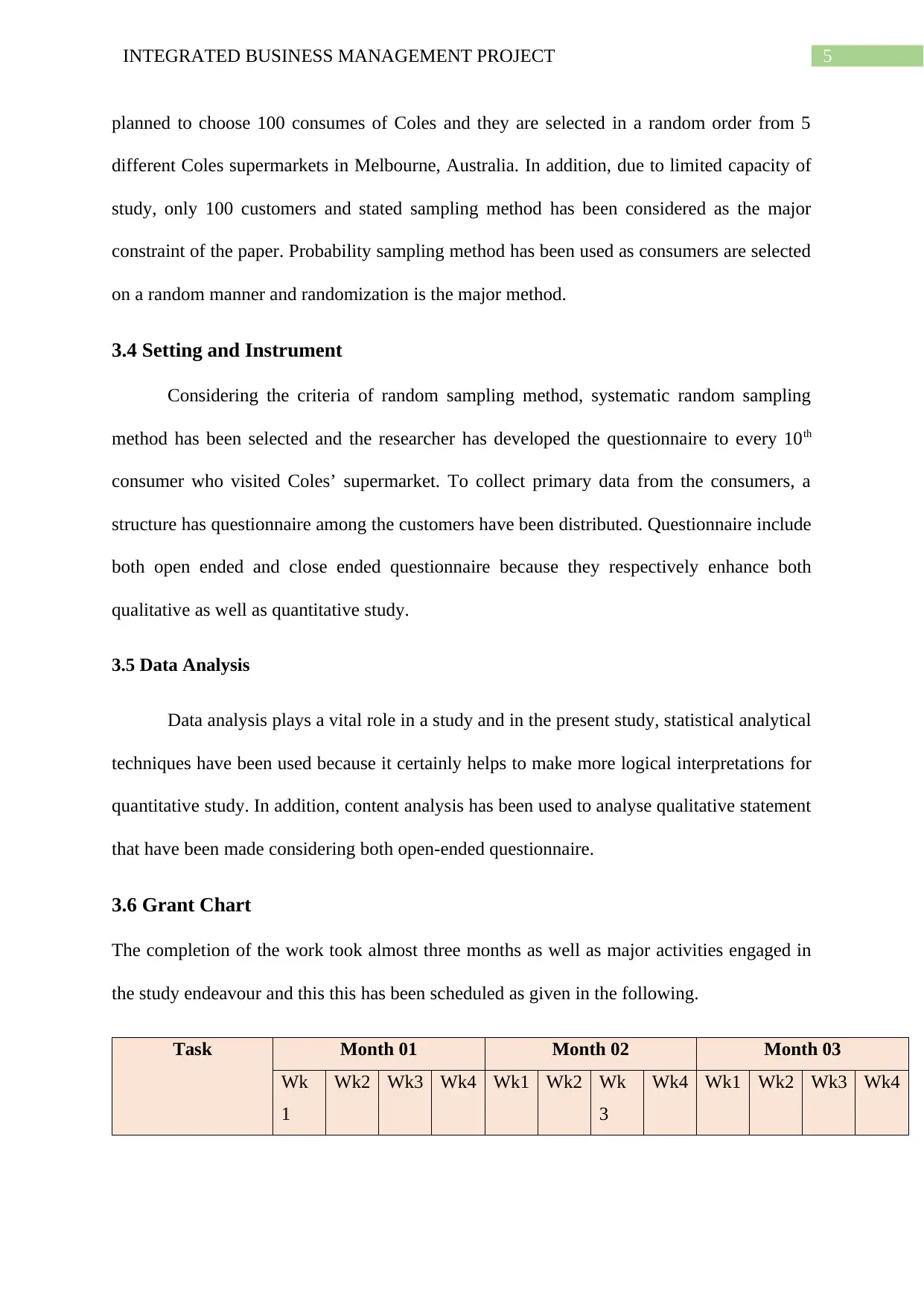
5INTEGRATED BUSINESS MANAGEMENT PROJECT
planned to choose 100 consumes of Coles and they are selected in a random order from 5
different Coles supermarkets in Melbourne, Australia. In addition, due to limited capacity of
study, only 100 customers and stated sampling method has been considered as the major
constraint of the paper. Probability sampling method has been used as consumers are selected
on a random manner and randomization is the major method.
3.4 Setting and Instrument
Considering the criteria of random sampling method, systematic random sampling
method has been selected and the researcher has developed the questionnaire to every 10th
consumer who visited Coles’ supermarket. To collect primary data from the consumers, a
structure has questionnaire among the customers have been distributed. Questionnaire include
both open ended and close ended questionnaire because they respectively enhance both
qualitative as well as quantitative study.
3.5 Data Analysis
Data analysis plays a vital role in a study and in the present study, statistical analytical
techniques have been used because it certainly helps to make more logical interpretations for
quantitative study. In addition, content analysis has been used to analyse qualitative statement
that have been made considering both open-ended questionnaire.
3.6 Grant Chart
The completion of the work took almost three months as well as major activities engaged in
the study endeavour and this this has been scheduled as given in the following.
Task Month 01 Month 02 Month 03
Wk
1
Wk2 Wk3 Wk4 Wk1 Wk2 Wk
3
Wk4 Wk1 Wk2 Wk3 Wk4
planned to choose 100 consumes of Coles and they are selected in a random order from 5
different Coles supermarkets in Melbourne, Australia. In addition, due to limited capacity of
study, only 100 customers and stated sampling method has been considered as the major
constraint of the paper. Probability sampling method has been used as consumers are selected
on a random manner and randomization is the major method.
3.4 Setting and Instrument
Considering the criteria of random sampling method, systematic random sampling
method has been selected and the researcher has developed the questionnaire to every 10th
consumer who visited Coles’ supermarket. To collect primary data from the consumers, a
structure has questionnaire among the customers have been distributed. Questionnaire include
both open ended and close ended questionnaire because they respectively enhance both
qualitative as well as quantitative study.
3.5 Data Analysis
Data analysis plays a vital role in a study and in the present study, statistical analytical
techniques have been used because it certainly helps to make more logical interpretations for
quantitative study. In addition, content analysis has been used to analyse qualitative statement
that have been made considering both open-ended questionnaire.
3.6 Grant Chart
The completion of the work took almost three months as well as major activities engaged in
the study endeavour and this this has been scheduled as given in the following.
Task Month 01 Month 02 Month 03
Wk
1
Wk2 Wk3 Wk4 Wk1 Wk2 Wk
3
Wk4 Wk1 Wk2 Wk3 Wk4
⊘ This is a preview!⊘
Do you want full access?
Subscribe today to unlock all pages.

Trusted by 1+ million students worldwide
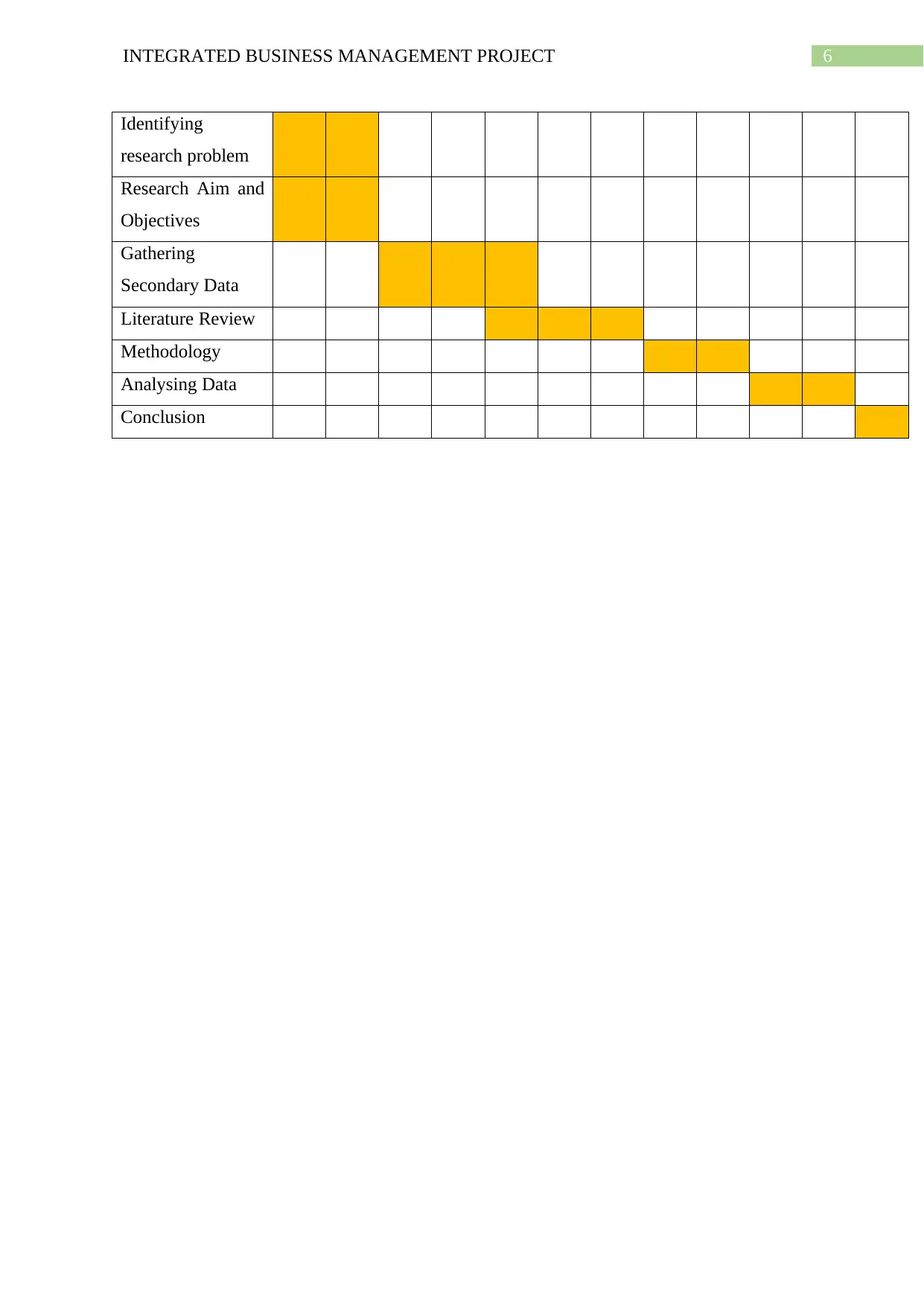
6INTEGRATED BUSINESS MANAGEMENT PROJECT
Identifying
research problem
Research Aim and
Objectives
Gathering
Secondary Data
Literature Review
Methodology
Analysing Data
Conclusion
Identifying
research problem
Research Aim and
Objectives
Gathering
Secondary Data
Literature Review
Methodology
Analysing Data
Conclusion
Paraphrase This Document
Need a fresh take? Get an instant paraphrase of this document with our AI Paraphraser
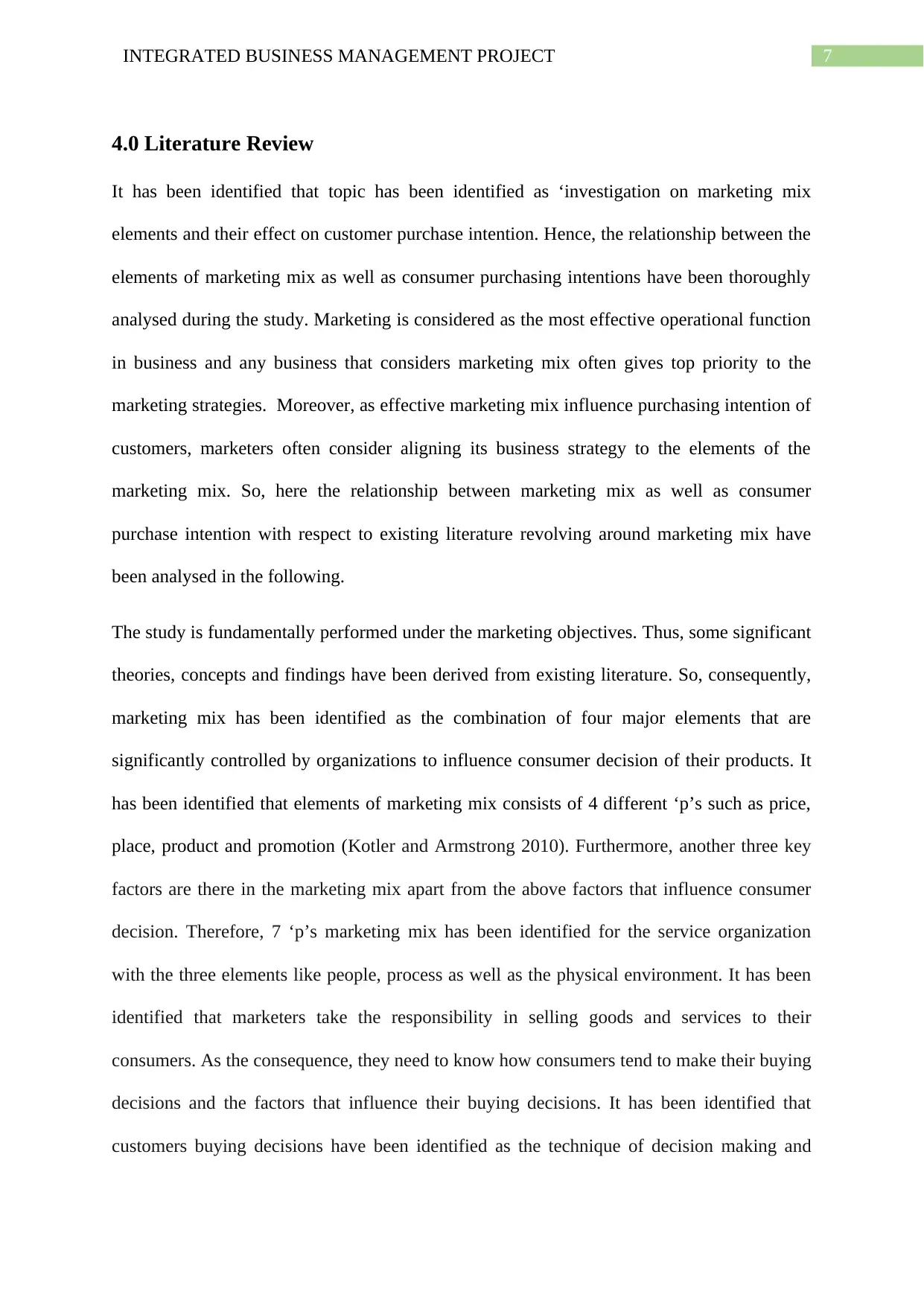
7INTEGRATED BUSINESS MANAGEMENT PROJECT
4.0 Literature Review
It has been identified that topic has been identified as ‘investigation on marketing mix
elements and their effect on customer purchase intention. Hence, the relationship between the
elements of marketing mix as well as consumer purchasing intentions have been thoroughly
analysed during the study. Marketing is considered as the most effective operational function
in business and any business that considers marketing mix often gives top priority to the
marketing strategies. Moreover, as effective marketing mix influence purchasing intention of
customers, marketers often consider aligning its business strategy to the elements of the
marketing mix. So, here the relationship between marketing mix as well as consumer
purchase intention with respect to existing literature revolving around marketing mix have
been analysed in the following.
The study is fundamentally performed under the marketing objectives. Thus, some significant
theories, concepts and findings have been derived from existing literature. So, consequently,
marketing mix has been identified as the combination of four major elements that are
significantly controlled by organizations to influence consumer decision of their products. It
has been identified that elements of marketing mix consists of 4 different ‘p’s such as price,
place, product and promotion (Kotler and Armstrong 2010). Furthermore, another three key
factors are there in the marketing mix apart from the above factors that influence consumer
decision. Therefore, 7 ‘p’s marketing mix has been identified for the service organization
with the three elements like people, process as well as the physical environment. It has been
identified that marketers take the responsibility in selling goods and services to their
consumers. As the consequence, they need to know how consumers tend to make their buying
decisions and the factors that influence their buying decisions. It has been identified that
customers buying decisions have been identified as the technique of decision making and
4.0 Literature Review
It has been identified that topic has been identified as ‘investigation on marketing mix
elements and their effect on customer purchase intention. Hence, the relationship between the
elements of marketing mix as well as consumer purchasing intentions have been thoroughly
analysed during the study. Marketing is considered as the most effective operational function
in business and any business that considers marketing mix often gives top priority to the
marketing strategies. Moreover, as effective marketing mix influence purchasing intention of
customers, marketers often consider aligning its business strategy to the elements of the
marketing mix. So, here the relationship between marketing mix as well as consumer
purchase intention with respect to existing literature revolving around marketing mix have
been analysed in the following.
The study is fundamentally performed under the marketing objectives. Thus, some significant
theories, concepts and findings have been derived from existing literature. So, consequently,
marketing mix has been identified as the combination of four major elements that are
significantly controlled by organizations to influence consumer decision of their products. It
has been identified that elements of marketing mix consists of 4 different ‘p’s such as price,
place, product and promotion (Kotler and Armstrong 2010). Furthermore, another three key
factors are there in the marketing mix apart from the above factors that influence consumer
decision. Therefore, 7 ‘p’s marketing mix has been identified for the service organization
with the three elements like people, process as well as the physical environment. It has been
identified that marketers take the responsibility in selling goods and services to their
consumers. As the consequence, they need to know how consumers tend to make their buying
decisions and the factors that influence their buying decisions. It has been identified that
customers buying decisions have been identified as the technique of decision making and
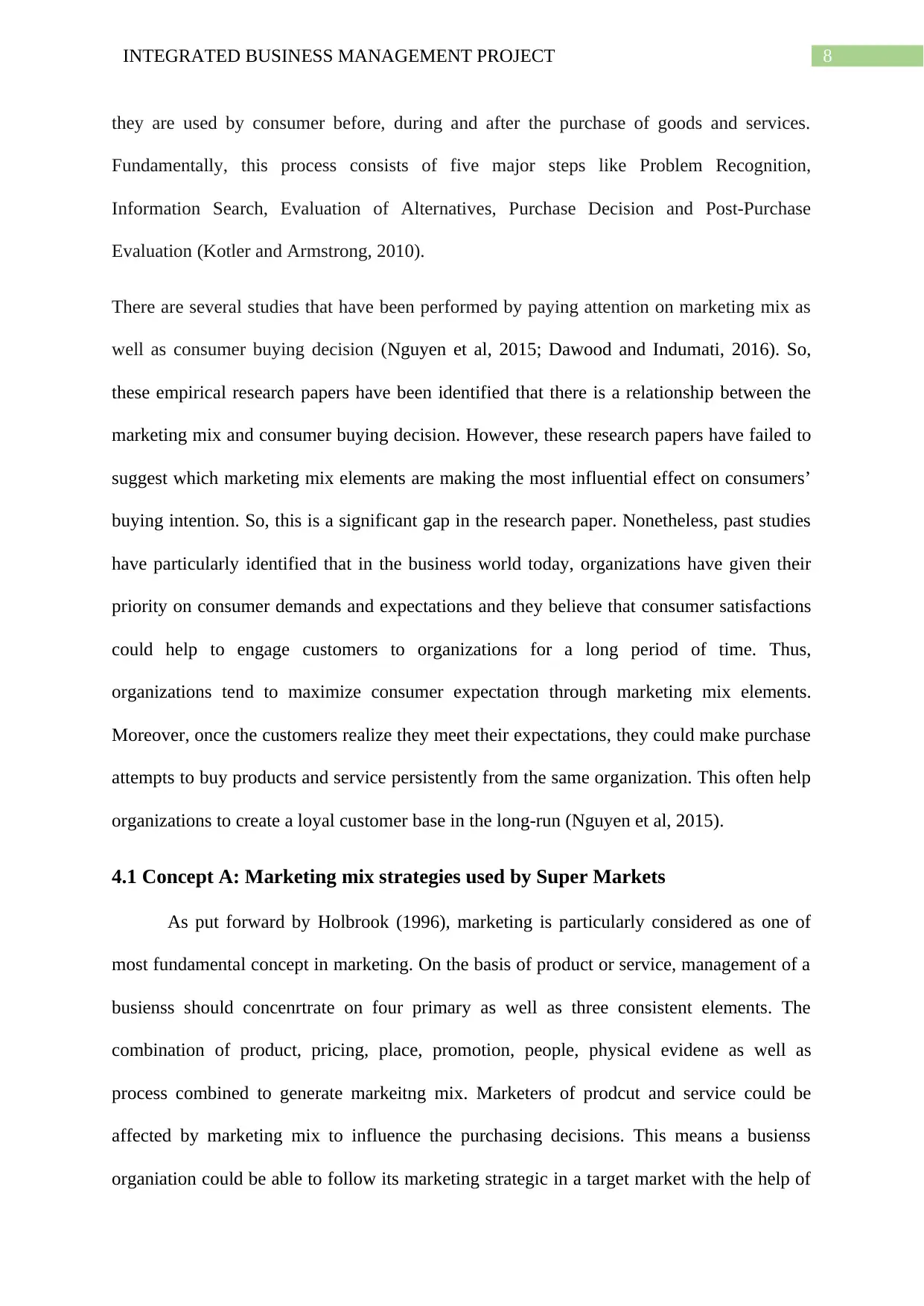
8INTEGRATED BUSINESS MANAGEMENT PROJECT
they are used by consumer before, during and after the purchase of goods and services.
Fundamentally, this process consists of five major steps like Problem Recognition,
Information Search, Evaluation of Alternatives, Purchase Decision and Post-Purchase
Evaluation (Kotler and Armstrong, 2010).
There are several studies that have been performed by paying attention on marketing mix as
well as consumer buying decision (Nguyen et al, 2015; Dawood and Indumati, 2016). So,
these empirical research papers have been identified that there is a relationship between the
marketing mix and consumer buying decision. However, these research papers have failed to
suggest which marketing mix elements are making the most influential effect on consumers’
buying intention. So, this is a significant gap in the research paper. Nonetheless, past studies
have particularly identified that in the business world today, organizations have given their
priority on consumer demands and expectations and they believe that consumer satisfactions
could help to engage customers to organizations for a long period of time. Thus,
organizations tend to maximize consumer expectation through marketing mix elements.
Moreover, once the customers realize they meet their expectations, they could make purchase
attempts to buy products and service persistently from the same organization. This often help
organizations to create a loyal customer base in the long-run (Nguyen et al, 2015).
4.1 Concept A: Marketing mix strategies used by Super Markets
As put forward by Holbrook (1996), marketing is particularly considered as one of
most fundamental concept in marketing. On the basis of product or service, management of a
busienss should concenrtrate on four primary as well as three consistent elements. The
combination of product, pricing, place, promotion, people, physical evidene as well as
process combined to generate markeitng mix. Marketers of prodcut and service could be
affected by marketing mix to influence the purchasing decisions. This means a busienss
organiation could be able to follow its marketing strategic in a target market with the help of
they are used by consumer before, during and after the purchase of goods and services.
Fundamentally, this process consists of five major steps like Problem Recognition,
Information Search, Evaluation of Alternatives, Purchase Decision and Post-Purchase
Evaluation (Kotler and Armstrong, 2010).
There are several studies that have been performed by paying attention on marketing mix as
well as consumer buying decision (Nguyen et al, 2015; Dawood and Indumati, 2016). So,
these empirical research papers have been identified that there is a relationship between the
marketing mix and consumer buying decision. However, these research papers have failed to
suggest which marketing mix elements are making the most influential effect on consumers’
buying intention. So, this is a significant gap in the research paper. Nonetheless, past studies
have particularly identified that in the business world today, organizations have given their
priority on consumer demands and expectations and they believe that consumer satisfactions
could help to engage customers to organizations for a long period of time. Thus,
organizations tend to maximize consumer expectation through marketing mix elements.
Moreover, once the customers realize they meet their expectations, they could make purchase
attempts to buy products and service persistently from the same organization. This often help
organizations to create a loyal customer base in the long-run (Nguyen et al, 2015).
4.1 Concept A: Marketing mix strategies used by Super Markets
As put forward by Holbrook (1996), marketing is particularly considered as one of
most fundamental concept in marketing. On the basis of product or service, management of a
busienss should concenrtrate on four primary as well as three consistent elements. The
combination of product, pricing, place, promotion, people, physical evidene as well as
process combined to generate markeitng mix. Marketers of prodcut and service could be
affected by marketing mix to influence the purchasing decisions. This means a busienss
organiation could be able to follow its marketing strategic in a target market with the help of
⊘ This is a preview!⊘
Do you want full access?
Subscribe today to unlock all pages.

Trusted by 1+ million students worldwide
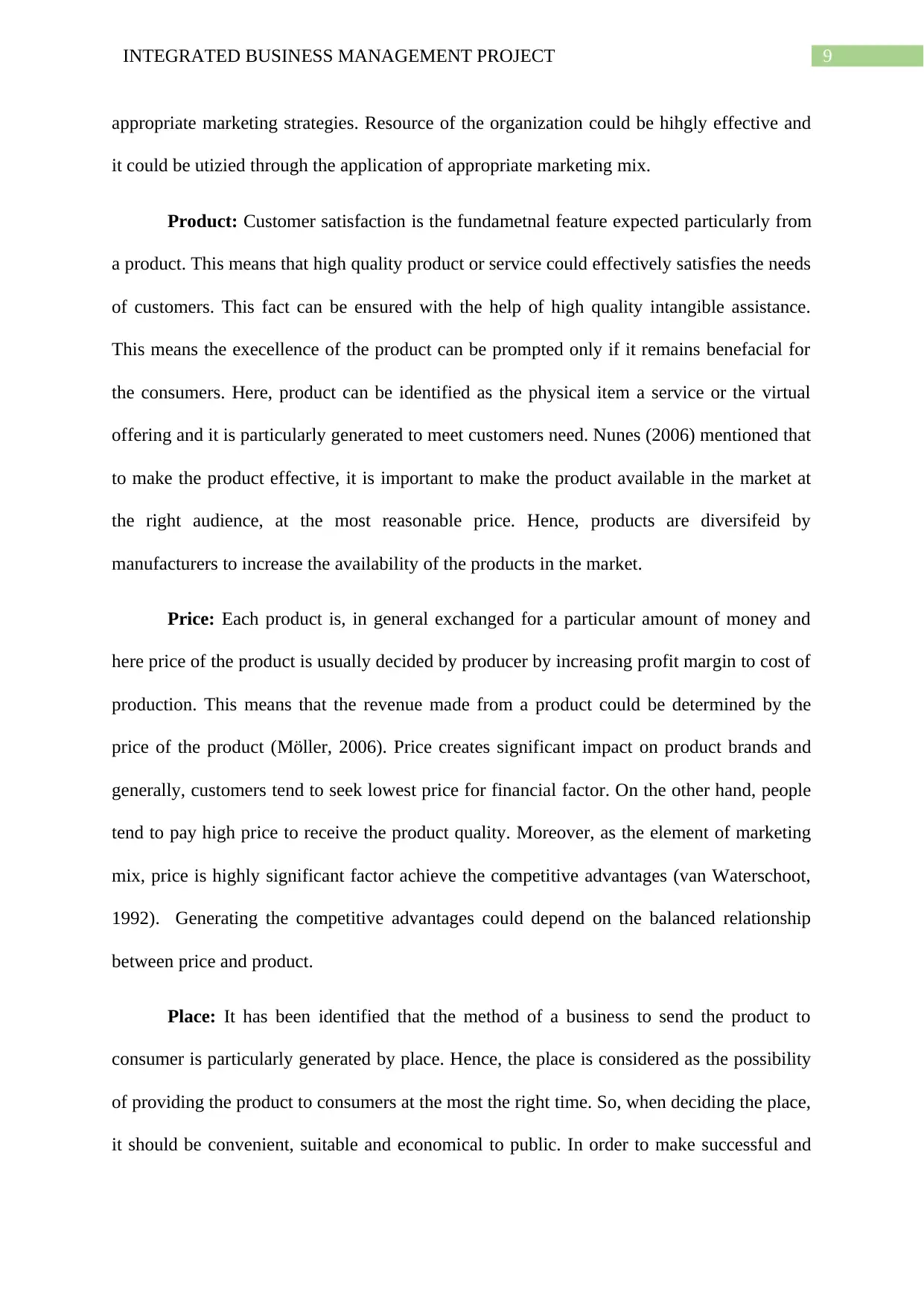
9INTEGRATED BUSINESS MANAGEMENT PROJECT
appropriate marketing strategies. Resource of the organization could be hihgly effective and
it could be utizied through the application of appropriate marketing mix.
Product: Customer satisfaction is the fundametnal feature expected particularly from
a product. This means that high quality product or service could effectively satisfies the needs
of customers. This fact can be ensured with the help of high quality intangible assistance.
This means the execellence of the product can be prompted only if it remains benefacial for
the consumers. Here, product can be identified as the physical item a service or the virtual
offering and it is particularly generated to meet customers need. Nunes (2006) mentioned that
to make the product effective, it is important to make the product available in the market at
the right audience, at the most reasonable price. Hence, products are diversifeid by
manufacturers to increase the availability of the products in the market.
Price: Each product is, in general exchanged for a particular amount of money and
here price of the product is usually decided by producer by increasing profit margin to cost of
production. This means that the revenue made from a product could be determined by the
price of the product (Möller, 2006). Price creates significant impact on product brands and
generally, customers tend to seek lowest price for financial factor. On the other hand, people
tend to pay high price to receive the product quality. Moreover, as the element of marketing
mix, price is highly significant factor achieve the competitive advantages (van Waterschoot,
1992). Generating the competitive advantages could depend on the balanced relationship
between price and product.
Place: It has been identified that the method of a business to send the product to
consumer is particularly generated by place. Hence, the place is considered as the possibility
of providing the product to consumers at the most the right time. So, when deciding the place,
it should be convenient, suitable and economical to public. In order to make successful and
appropriate marketing strategies. Resource of the organization could be hihgly effective and
it could be utizied through the application of appropriate marketing mix.
Product: Customer satisfaction is the fundametnal feature expected particularly from
a product. This means that high quality product or service could effectively satisfies the needs
of customers. This fact can be ensured with the help of high quality intangible assistance.
This means the execellence of the product can be prompted only if it remains benefacial for
the consumers. Here, product can be identified as the physical item a service or the virtual
offering and it is particularly generated to meet customers need. Nunes (2006) mentioned that
to make the product effective, it is important to make the product available in the market at
the right audience, at the most reasonable price. Hence, products are diversifeid by
manufacturers to increase the availability of the products in the market.
Price: Each product is, in general exchanged for a particular amount of money and
here price of the product is usually decided by producer by increasing profit margin to cost of
production. This means that the revenue made from a product could be determined by the
price of the product (Möller, 2006). Price creates significant impact on product brands and
generally, customers tend to seek lowest price for financial factor. On the other hand, people
tend to pay high price to receive the product quality. Moreover, as the element of marketing
mix, price is highly significant factor achieve the competitive advantages (van Waterschoot,
1992). Generating the competitive advantages could depend on the balanced relationship
between price and product.
Place: It has been identified that the method of a business to send the product to
consumer is particularly generated by place. Hence, the place is considered as the possibility
of providing the product to consumers at the most the right time. So, when deciding the place,
it should be convenient, suitable and economical to public. In order to make successful and
Paraphrase This Document
Need a fresh take? Get an instant paraphrase of this document with our AI Paraphraser
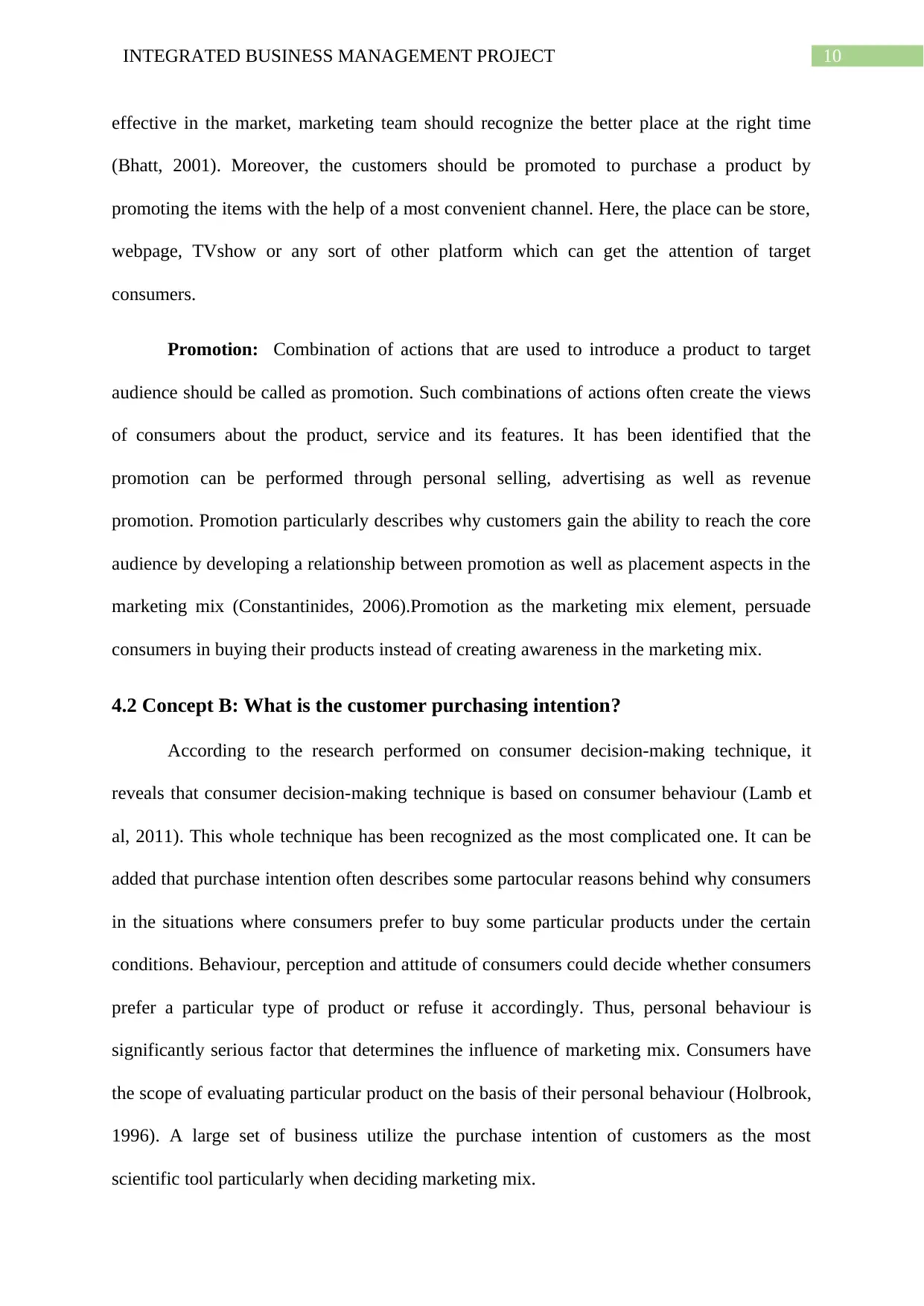
10INTEGRATED BUSINESS MANAGEMENT PROJECT
effective in the market, marketing team should recognize the better place at the right time
(Bhatt, 2001). Moreover, the customers should be promoted to purchase a product by
promoting the items with the help of a most convenient channel. Here, the place can be store,
webpage, TVshow or any sort of other platform which can get the attention of target
consumers.
Promotion: Combination of actions that are used to introduce a product to target
audience should be called as promotion. Such combinations of actions often create the views
of consumers about the product, service and its features. It has been identified that the
promotion can be performed through personal selling, advertising as well as revenue
promotion. Promotion particularly describes why customers gain the ability to reach the core
audience by developing a relationship between promotion as well as placement aspects in the
marketing mix (Constantinides, 2006).Promotion as the marketing mix element, persuade
consumers in buying their products instead of creating awareness in the marketing mix.
4.2 Concept B: What is the customer purchasing intention?
According to the research performed on consumer decision-making technique, it
reveals that consumer decision-making technique is based on consumer behaviour (Lamb et
al, 2011). This whole technique has been recognized as the most complicated one. It can be
added that purchase intention often describes some partocular reasons behind why consumers
in the situations where consumers prefer to buy some particular products under the certain
conditions. Behaviour, perception and attitude of consumers could decide whether consumers
prefer a particular type of product or refuse it accordingly. Thus, personal behaviour is
significantly serious factor that determines the influence of marketing mix. Consumers have
the scope of evaluating particular product on the basis of their personal behaviour (Holbrook,
1996). A large set of business utilize the purchase intention of customers as the most
scientific tool particularly when deciding marketing mix.
effective in the market, marketing team should recognize the better place at the right time
(Bhatt, 2001). Moreover, the customers should be promoted to purchase a product by
promoting the items with the help of a most convenient channel. Here, the place can be store,
webpage, TVshow or any sort of other platform which can get the attention of target
consumers.
Promotion: Combination of actions that are used to introduce a product to target
audience should be called as promotion. Such combinations of actions often create the views
of consumers about the product, service and its features. It has been identified that the
promotion can be performed through personal selling, advertising as well as revenue
promotion. Promotion particularly describes why customers gain the ability to reach the core
audience by developing a relationship between promotion as well as placement aspects in the
marketing mix (Constantinides, 2006).Promotion as the marketing mix element, persuade
consumers in buying their products instead of creating awareness in the marketing mix.
4.2 Concept B: What is the customer purchasing intention?
According to the research performed on consumer decision-making technique, it
reveals that consumer decision-making technique is based on consumer behaviour (Lamb et
al, 2011). This whole technique has been recognized as the most complicated one. It can be
added that purchase intention often describes some partocular reasons behind why consumers
in the situations where consumers prefer to buy some particular products under the certain
conditions. Behaviour, perception and attitude of consumers could decide whether consumers
prefer a particular type of product or refuse it accordingly. Thus, personal behaviour is
significantly serious factor that determines the influence of marketing mix. Consumers have
the scope of evaluating particular product on the basis of their personal behaviour (Holbrook,
1996). A large set of business utilize the purchase intention of customers as the most
scientific tool particularly when deciding marketing mix.
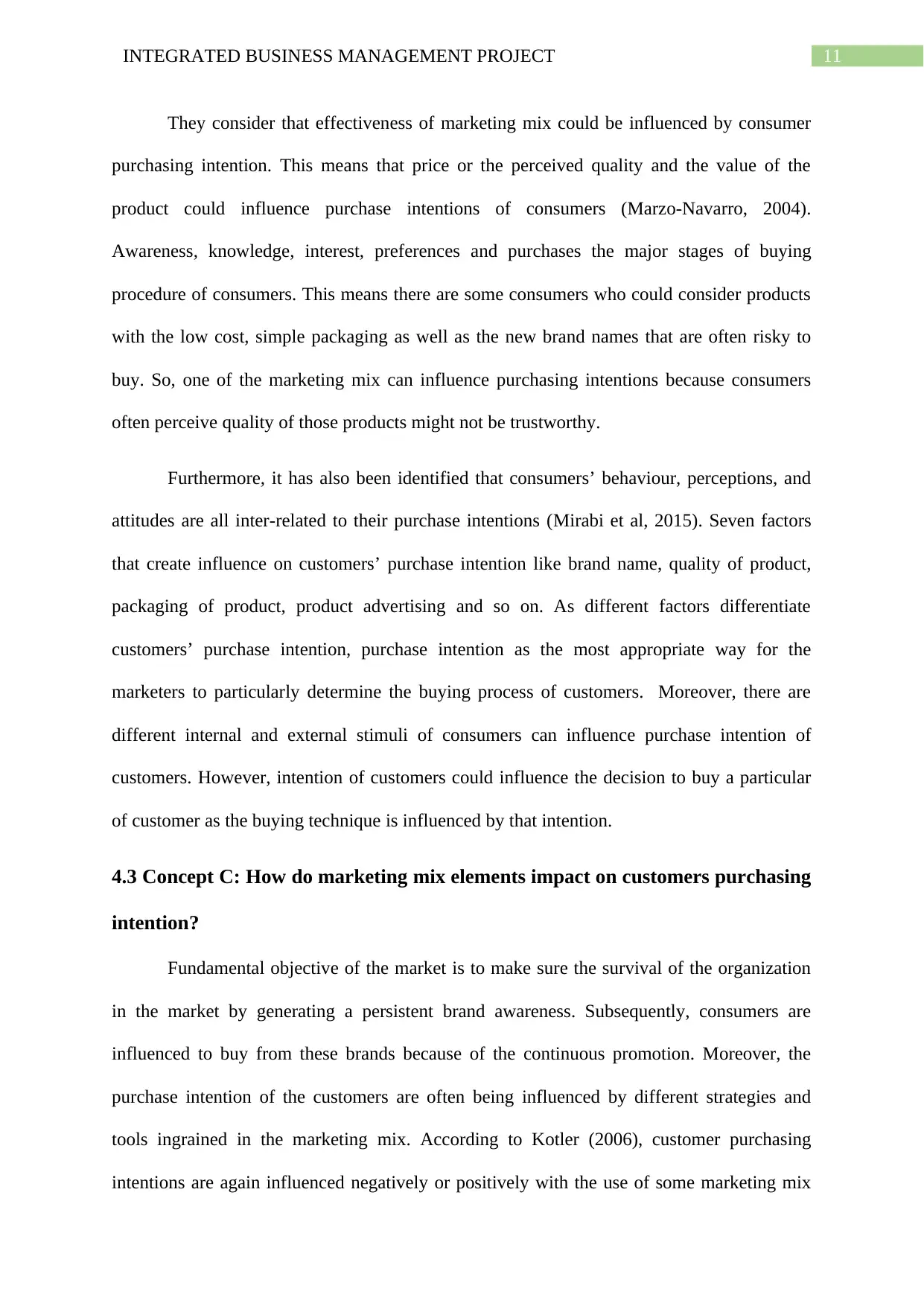
11INTEGRATED BUSINESS MANAGEMENT PROJECT
They consider that effectiveness of marketing mix could be influenced by consumer
purchasing intention. This means that price or the perceived quality and the value of the
product could influence purchase intentions of consumers (Marzo-Navarro, 2004).
Awareness, knowledge, interest, preferences and purchases the major stages of buying
procedure of consumers. This means there are some consumers who could consider products
with the low cost, simple packaging as well as the new brand names that are often risky to
buy. So, one of the marketing mix can influence purchasing intentions because consumers
often perceive quality of those products might not be trustworthy.
Furthermore, it has also been identified that consumers’ behaviour, perceptions, and
attitudes are all inter-related to their purchase intentions (Mirabi et al, 2015). Seven factors
that create influence on customers’ purchase intention like brand name, quality of product,
packaging of product, product advertising and so on. As different factors differentiate
customers’ purchase intention, purchase intention as the most appropriate way for the
marketers to particularly determine the buying process of customers. Moreover, there are
different internal and external stimuli of consumers can influence purchase intention of
customers. However, intention of customers could influence the decision to buy a particular
of customer as the buying technique is influenced by that intention.
4.3 Concept C: How do marketing mix elements impact on customers purchasing
intention?
Fundamental objective of the market is to make sure the survival of the organization
in the market by generating a persistent brand awareness. Subsequently, consumers are
influenced to buy from these brands because of the continuous promotion. Moreover, the
purchase intention of the customers are often being influenced by different strategies and
tools ingrained in the marketing mix. According to Kotler (2006), customer purchasing
intentions are again influenced negatively or positively with the use of some marketing mix
They consider that effectiveness of marketing mix could be influenced by consumer
purchasing intention. This means that price or the perceived quality and the value of the
product could influence purchase intentions of consumers (Marzo-Navarro, 2004).
Awareness, knowledge, interest, preferences and purchases the major stages of buying
procedure of consumers. This means there are some consumers who could consider products
with the low cost, simple packaging as well as the new brand names that are often risky to
buy. So, one of the marketing mix can influence purchasing intentions because consumers
often perceive quality of those products might not be trustworthy.
Furthermore, it has also been identified that consumers’ behaviour, perceptions, and
attitudes are all inter-related to their purchase intentions (Mirabi et al, 2015). Seven factors
that create influence on customers’ purchase intention like brand name, quality of product,
packaging of product, product advertising and so on. As different factors differentiate
customers’ purchase intention, purchase intention as the most appropriate way for the
marketers to particularly determine the buying process of customers. Moreover, there are
different internal and external stimuli of consumers can influence purchase intention of
customers. However, intention of customers could influence the decision to buy a particular
of customer as the buying technique is influenced by that intention.
4.3 Concept C: How do marketing mix elements impact on customers purchasing
intention?
Fundamental objective of the market is to make sure the survival of the organization
in the market by generating a persistent brand awareness. Subsequently, consumers are
influenced to buy from these brands because of the continuous promotion. Moreover, the
purchase intention of the customers are often being influenced by different strategies and
tools ingrained in the marketing mix. According to Kotler (2006), customer purchasing
intentions are again influenced negatively or positively with the use of some marketing mix
⊘ This is a preview!⊘
Do you want full access?
Subscribe today to unlock all pages.

Trusted by 1+ million students worldwide
1 out of 24
Related Documents
Your All-in-One AI-Powered Toolkit for Academic Success.
+13062052269
info@desklib.com
Available 24*7 on WhatsApp / Email
![[object Object]](/_next/static/media/star-bottom.7253800d.svg)
Unlock your academic potential
Copyright © 2020–2025 A2Z Services. All Rights Reserved. Developed and managed by ZUCOL.




